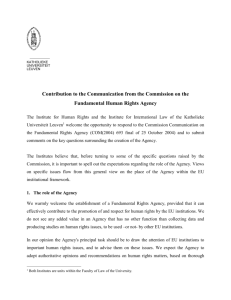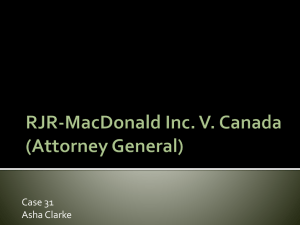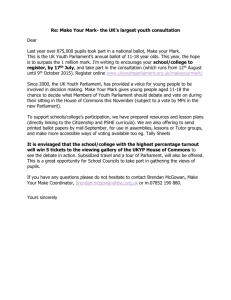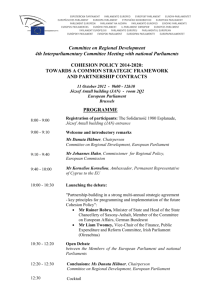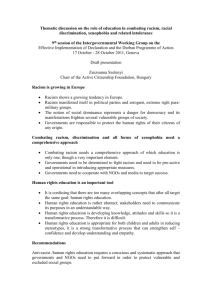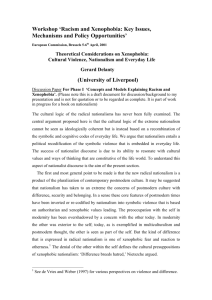Elena Paciotti - Europeanrights.eu
advertisement
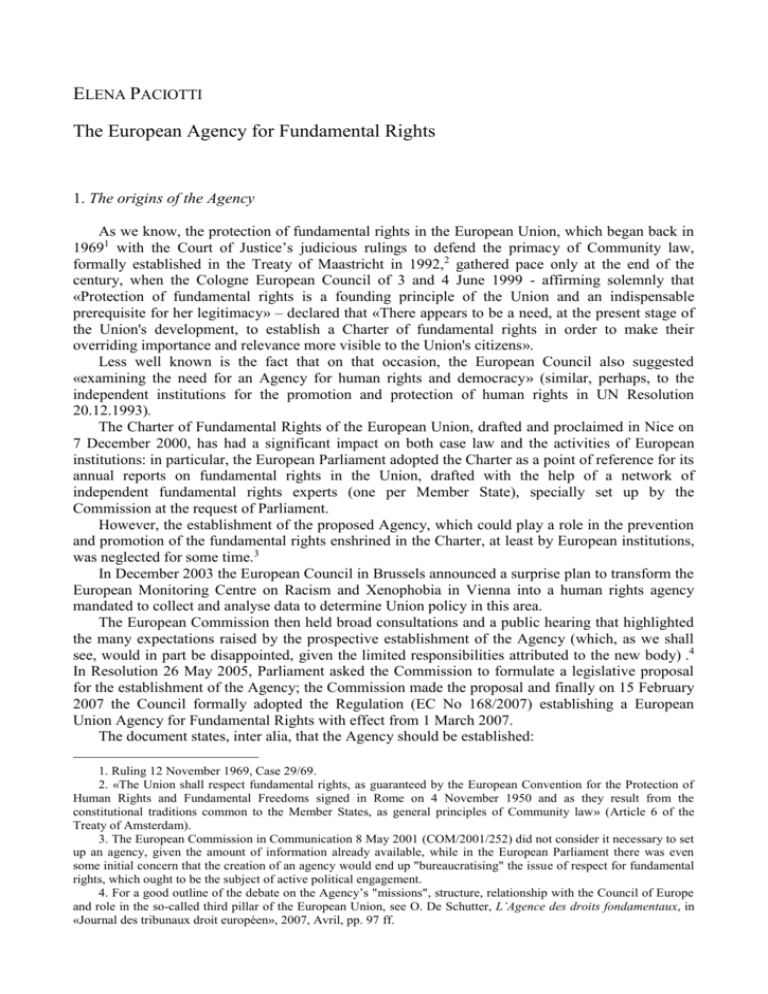
ELENA PACIOTTI The European Agency for Fundamental Rights 1. The origins of the Agency As we know, the protection of fundamental rights in the European Union, which began back in 19691 with the Court of Justice’s judicious rulings to defend the primacy of Community law, formally established in the Treaty of Maastricht in 1992,2 gathered pace only at the end of the century, when the Cologne European Council of 3 and 4 June 1999 - affirming solemnly that «Protection of fundamental rights is a founding principle of the Union and an indispensable prerequisite for her legitimacy» – declared that «There appears to be a need, at the present stage of the Union's development, to establish a Charter of fundamental rights in order to make their overriding importance and relevance more visible to the Union's citizens». Less well known is the fact that on that occasion, the European Council also suggested «examining the need for an Agency for human rights and democracy» (similar, perhaps, to the independent institutions for the promotion and protection of human rights in UN Resolution 20.12.1993). The Charter of Fundamental Rights of the European Union, drafted and proclaimed in Nice on 7 December 2000, has had a significant impact on both case law and the activities of European institutions: in particular, the European Parliament adopted the Charter as a point of reference for its annual reports on fundamental rights in the Union, drafted with the help of a network of independent fundamental rights experts (one per Member State), specially set up by the Commission at the request of Parliament. However, the establishment of the proposed Agency, which could play a role in the prevention and promotion of the fundamental rights enshrined in the Charter, at least by European institutions, was neglected for some time.3 In December 2003 the European Council in Brussels announced a surprise plan to transform the European Monitoring Centre on Racism and Xenophobia in Vienna into a human rights agency mandated to collect and analyse data to determine Union policy in this area. The European Commission then held broad consultations and a public hearing that highlighted the many expectations raised by the prospective establishment of the Agency (which, as we shall see, would in part be disappointed, given the limited responsibilities attributed to the new body) .4 In Resolution 26 May 2005, Parliament asked the Commission to formulate a legislative proposal for the establishment of the Agency; the Commission made the proposal and finally on 15 February 2007 the Council formally adopted the Regulation (EC No 168/2007) establishing a European Union Agency for Fundamental Rights with effect from 1 March 2007. The document states, inter alia, that the Agency should be established: 1. Ruling 12 November 1969, Case 29/69. 2. «The Union shall respect fundamental rights, as guaranteed by the European Convention for the Protection of Human Rights and Fundamental Freedoms signed in Rome on 4 November 1950 and as they result from the constitutional traditions common to the Member States, as general principles of Community law» (Article 6 of the Treaty of Amsterdam). 3. The European Commission in Communication 8 May 2001 (COM/2001/252) did not consider it necessary to set up an agency, given the amount of information already available, while in the European Parliament there was even some initial concern that the creation of an agency would end up "bureaucratising" the issue of respect for fundamental rights, which ought to be the subject of active political engagement. 4. For a good outline of the debate on the Agency’s "missions", structure, relationship with the Council of Europe and role in the so-called third pillar of the European Union, see O. De Schutter, L’Agence des droits fondamentaux, in «Journal des tribunaux droit européen», 2007, Avril, pp. 97 ff. to provide the relevant institutions and authorities of the Community and its Member States when implementing Community law with information, assistance and expertise on fundamental rights in order to support them when they take measures or formulate courses of action within their respective spheres of competence to fully respect fundamental rights. [Furthermore] As the Agency is to be built upon the existing European Monitoring Centre on Racism and Xenophobia, the work of the Agency should continue to cover the phenomena of racism, xenophobia and anti-Semitism, the protection of rights of persons belonging to minorities, as well as gender equality, as essential elements for the protection of fundamental rights. In other words, the Agency was to take over the work of the Centre, and Regulation (EC No 1035/97) establishing the Centre was in fact repealed with effect from 1 March 2007. The bodies of the Agency comprise (Articles 12, 13, 14 and 15 Regulation 168/2007): Management Board, composed of independent persons appointed (a member and an alternate member) by each of the twenty-seven Member States and the Council of Europe, and two representatives of the European Commission; Executive Board, made up of the Chairperson and the Vice-Chairperson of the Management Board, two other members of the Management Board and a representative the European Commission; the person appointed by the Council of Europe may participate in the meetings of the Executive Board; The Scientific Committee, composed of eleven independent persons, highly qualified in the field of fundamental rights, appointed by the Management Board after having consulted the competent committee of the European Parliament; Director. The Agency cooperates with national and international organizations: each Member State nominates a government official as a National Liaison Officer and the Agency cooperates with national institutions for human rights and with international organizations such as OSCE and the United Nations (Article 8). It also cooperates closely with the Council of Europe and civil society (Articles 9 and 10). 2. A difficult beginning 2.1. The transformation of the Centre on Racism and Xenophobia into the Agency for Fundamental Rights So, on 1 March 2007 what until then was known as the Centre on Racism and Xenophobia became the Agency for Fundamental Rights. This transformation was not a short process but in the end was finally accomplished. The new Management Board met to appoint the Executive Board in July 2007. But the appointment of a new director took much longer because of the complex procedures envisaged in Regulation – the Agency Management Board was to choose from a list of candidates prepared by the Commission, having heard the views of the Council and Parliament; furthermore, the Parliament and the Management Board protested over the decision of the European Commission to submit a list of only two persons, one a Community human rights expert and the other a UN human rights expert, thus making the decision inevitable. In the spring of 2008, a new director (selected – one may say - by the Commission in consultation with the governments of the Member States), was formally appointed, and took office on 1 June 2008. After a selection procedure which also proved to be anything but simple, the Scientific Council was nominated by the Management Board in June 2008. On 18 June 2008 an agreement was signed between the European Community and the Council of Europe on cooperation between the Agency and the Council of Europe. Finally, the “Fundamental Rights Platform” was set up, an instrument for cooperation with civil society. This, in the opinion of the writer, was an unexpected success, given the indeterminacy and vagueness of the regulations, according to which (Article 10 168/2007) the Agency «establishes a cooperation network (Fundamental Rights Platform), composed of non-governmental organisations dealing with human rights, trade unions and employer's organisations, relevant social and professional organisations, churches, religious, philosophical and non-confessional organisations, universities and other qualified experts of European and international bodies and organisations», also having the task, inter alia, of making proposals for the annual programme and the follow-up of the Agency's annual report. It was hard to imagine how, in a European Union consisting of twentyseven countries, it could be possible to bring together so many different organizations (trade unions, religious organizations, academia, etc), but in this case, bureaucratic practice made it possible to solve the problem. After informal consultations, an announcement was published inviting organisations to join the “Platform”; the call was taken up by the most active non-governmental organizations for the protection of human rights, which, in the first meeting of 7-8 October, 2008, were able to present to the Management Board a detailed proposal for the Agency's programme. Subsequent calls broadened the membership of the “Platform” Inevitably, the Agency's annual reports for 2007 and 2008 (obviously each regarding the previous year) focused, like those of the Centre, on the phenomena of racism and xenophobia, because the Agency could only base its activities on the monitoring system that had been set up by the Centre, the RAXEN network, composed of 25 National Focal Points), one in each EU Member State, to provided data and information on these phenomena. Also the important special report on violence against Roma in the Ponticelli district of Naples, published by the Agency on August 5, 2008, was based on information provided by RAXEN’s Italian focal point. Moreover, in 2007 the Agency set up a new network of national human rights experts to provide studies and reports for comparative analysis, the FRALEX network, which includes academics who had been part of the network of independent experts created by the Commission at the request of the European Parliament. Thus, especially in the second half of 2008, by which time all Agency bodies had become operational - in particular the new Director and the Scientific Committee - and cooperation with civil society had been activated, the Agency began expanding on the work of its predecessor, the Centre, and started to carry out the broader functions it had been given in the constituent regulation, providing critical analysis and advice on all areas concerning the protection of fundamental rights. This necessary development was also due to the initiatives of European institutions, which requested reports, information and opinions from the Agency. In particular, at the request of the European Parliament, the Agency carried out research on homophobia and discrimination based on sexual orientation and, with the collaboration of the FRALEX network, published a report in two parts: the first, in 2008, concerning legal aspects, the second, in 2009, on the social situation. Furthermore, at the request of the Presidency of the EU Council, the Agency was asked for its opinion on the proposed Framework Decision on the use of personal data of airline passengers, an opinion which, thanks to quick work of the Scientific Committee, was given in October 2008: this was the first opinion to be requested in the course of legislative proceedings. Other research in different fields is conducted by third parties, selected and contracted by the Agency on the basis of public competition announcements. 2.2. Problems that are being solved One of the most debated issues during the process to set up the Agency was the fear that the Agency’s functions and activities would overlap with those hitherto exercised by the Council of Europe. Now we can say that a solution to this problem is being found, thanks to measures introduced into the Regulation establishing the Agency and the special cooperation agreement stipulated between the Community (now European Union) and the Council of Europe, which managed to overcome mutual diffidence, at least in part, and initiated a phase of what promises to be constructive collaboration. Also, the different competences and roles – concerning, on the one hand, compliance with the European Convention on Human Rights by the 47 states belonging to the Council of Europe and, on the other hand, compliance with the broader Charter of fundamental rights by EU institutions and the 27 Member States in application of EU law – can produce effective interaction, if this is based on a truly cooperative and not competitive attitude. Moreover, the planned accession of the Union to the European Convention of Human Rights, although highly complex and yet to be implemented, will also help to define the relationship between the two institutions and especially between the two courts, the European Court of Human Rights and the European Court of Justice. The relationship will be similar to the one between the constitutional courts of European states and the Strasbourg Court, including the inevitable but sometimes useful disputes that arise. In this particular aspect, too, the tendency will be for the Court of Justice to take on the role of “EU Constitutional Court”. Another important innovation has recently been introduced: the Agency has just announced that it will be recruiting a research group made up of lawyers and social scientists in each member country to collect data, to provide information and to conduct studies. These means that efforts are being made to unify the FRALEX and RAXEN networks, the two networks, which until now were responsible for providing information, data and analysis on social issues and legal issues respectively. Because of the historical differences between the two networks (the RAXEN network inherited from the Centre on Racism and Xenophobia, the FRALEX network established by the Agency to handle the broader tasks assigned to it after taking over from the Centre) it was important to establish links between the two, to ensure consistent working methods and shared information. The solution adopted meets these needs. 3. Open problems Firstly, there is still the question of the Agency’s powers. In Resolution 26 May 2005, the European Parliament stressed that the creation of the Agency should contribute to strengthening mutual trust between Member States and constitute a guarantee of compliance with the principles laid down in Articles 6 and 7 of the Treaty on the European Union, which define human rights as founding Union values and gives the Council the power to adopt sanctions against a Member State committing a serious and persistent breach of these rights. But this prospect was not apparently shared by the Council, which stipulated in the Agency's constituent regulation that its function was to provide «assistance and expertise» and not to exercise control, and, more importantly, that this function is limited to the implementation of Community law. This excluded the field in which people’s fundamental rights are most at risk, judicial cooperation in criminal and police matters (the so-called third pillar). In addition, regulations stipulate that the Agency’s opinions and reports may not regard proposals or positions adopted within the framework of a legislative procedure, except at the request of the institution concerned (Article 4.2). It should be noted, however, that in carrying out the monitoring activities of the Centre on Racism and Xenophobia, at least in these areas, these activities indirectly involve exercising control and one of the specific responsibilities of the Agency is to collect, record, analyse and disseminate objective, reliable and comparable information and data, and to carry out studies and investigations (Article 4, 1.a, b Reg.), which in turn can be used as instruments to exercise control and assess Member States’ compliance with fundamental rights. However, this still amounts to a permanent limitation of the Agency’s responsibilities, which has disappointed many civil society expectations. Another limitation stems from a provision in the constituent Regulation, which conditions the Agency’s real independence. Article 5 of the Regulation states that the Agency shall carry out its tasks within the thematic areas determined by a Multiannual Framework adopted by the Council. In other words, it is the governments of the Member States which, as stated in the Agency’s constituent regulation, shall jointly establish every five years what is within and without the remit of the European Agency for Fundamental Rights. An example of this was the approval of the first multiannual framework adopted by the Council Decision of 28 February 2008. Given that the Agency can only deal with the application of Community law, which mainly concerns market regulation, both the European Parliament and the Agency's Management Board, after consultation, had proposed including, among the thematic areas of the Agency’s sphere of competence for the period 2007-2012, social rights, which evidently interfere with internal market rules, but the Council was firmly against. Thus, there remains an ongoing dispute between citizens’ expectations and the Agency's own aspirations, on the one hand, and the excessive caution of the Council, on the other. 4. Prospects The ratification of the Lisbon Treaty has changed this scenario. By giving the Charter (an amended text “proclaimed” in Strasbourg on 14 December 2007) the same legal value as the Treaties, the protection of fundamental rights within the European Union will become more effective; moreover, the inclusion of the so-called third pillar of the Union (judicial cooperation in criminal and police matters) within the framework of Community law is in itself an extension of the scope of the Agency’s activities to an area in which fundamental rights appear to be most at risk. The role and functions of the Agency will need to be reconsidered following the entry into force of the Treaty of Lisbon and the binding effects attributed to the Charter of Fundamental Rights. However, the importance attached to the protection of fundamental rights in the new Treaty seems to contrast with both the Agency's limited sphere of competence, as established in the Regulations, which excludes control activities and includes only assistance and advice in the field of Community law, and the further limitations represented by the specific areas of Agency intervention established by the Council with the adoption of the multiannual framework. In short, the fact that a body, which is supposed to be independent and responsible for the protection of fundamental rights, has had its sphere of competence limited by governments undermines the credibility of the Union’s commitment towards the protection of fundamental rights. This limits the Agency’s very independence and also precludes the European Parliament from having appropriate instruments, knowledge and expertise to assess compliance with fundamental rights. It is also important for the Agency to be able to cooperate concretely with other European Union bodies and agencies that operate in “sensitive” areas for the protection of rights, such as FRONTEX and EUROPOL, to monitor the coherence of the instruments adopted and the operational procedures to ensure compliance with fundamental rights. The current set up follows a bureaucratic logic, in which the Director has all the responsibility for the content of reports and opinions. Thus, is it important not only for the regulation to be fully and loyally respected as to the choice of the person given this responsibility but also for work methods to be based on collegiality and transparency. These methods should, in turn, not be entrusted solely to the ability and discretion of individuals but they must be made stable and public. It is hoped that the Agency will, in the eyes of European citizens, quickly gain a reputation for independent authority and seriousness and that the governments in the Council can understand that citizens’ trust is gained by offering them the best possible guarantee for their rights, and not by trying to limit their effectiveness.
